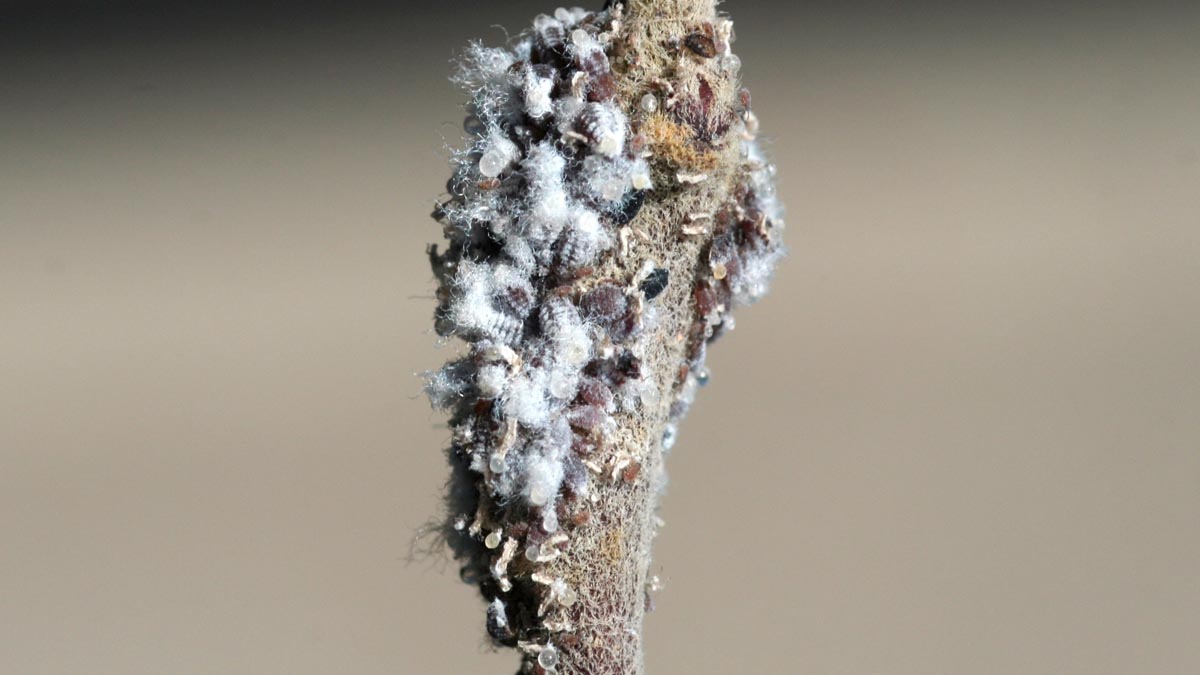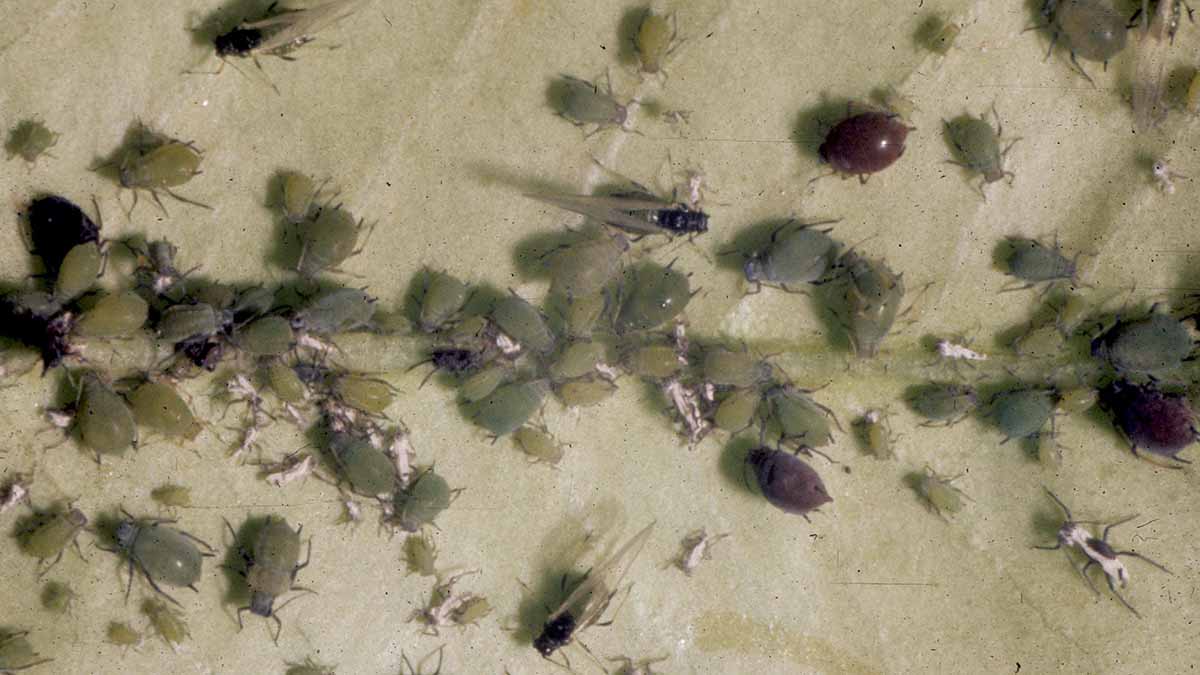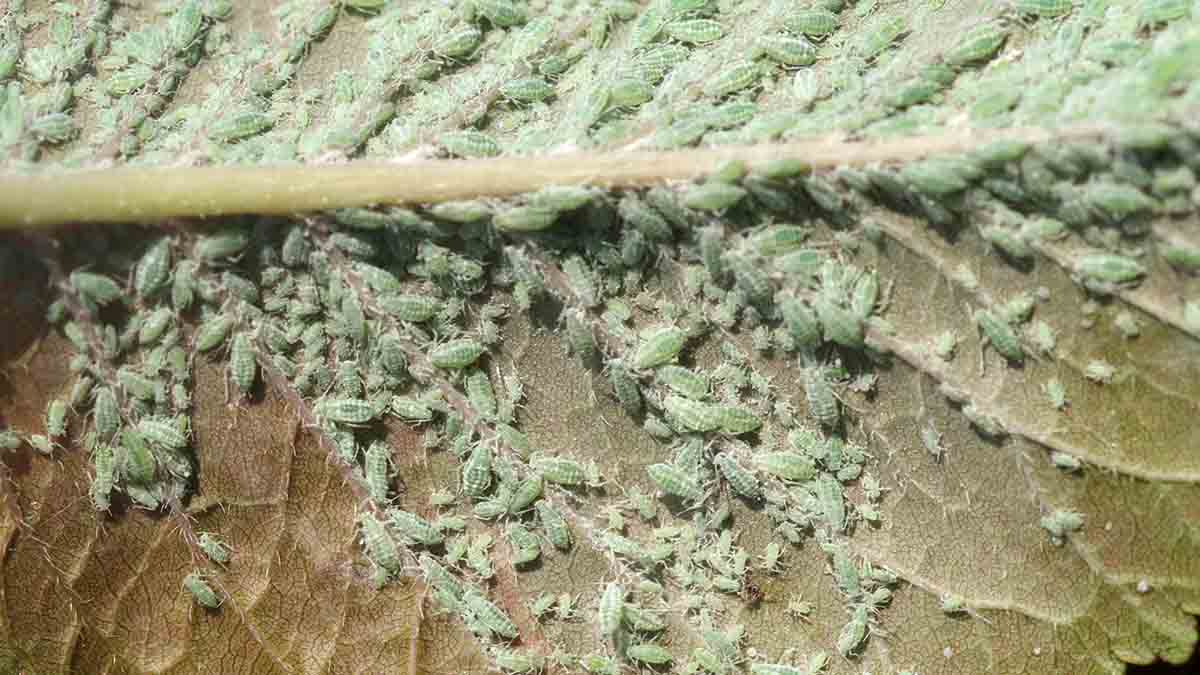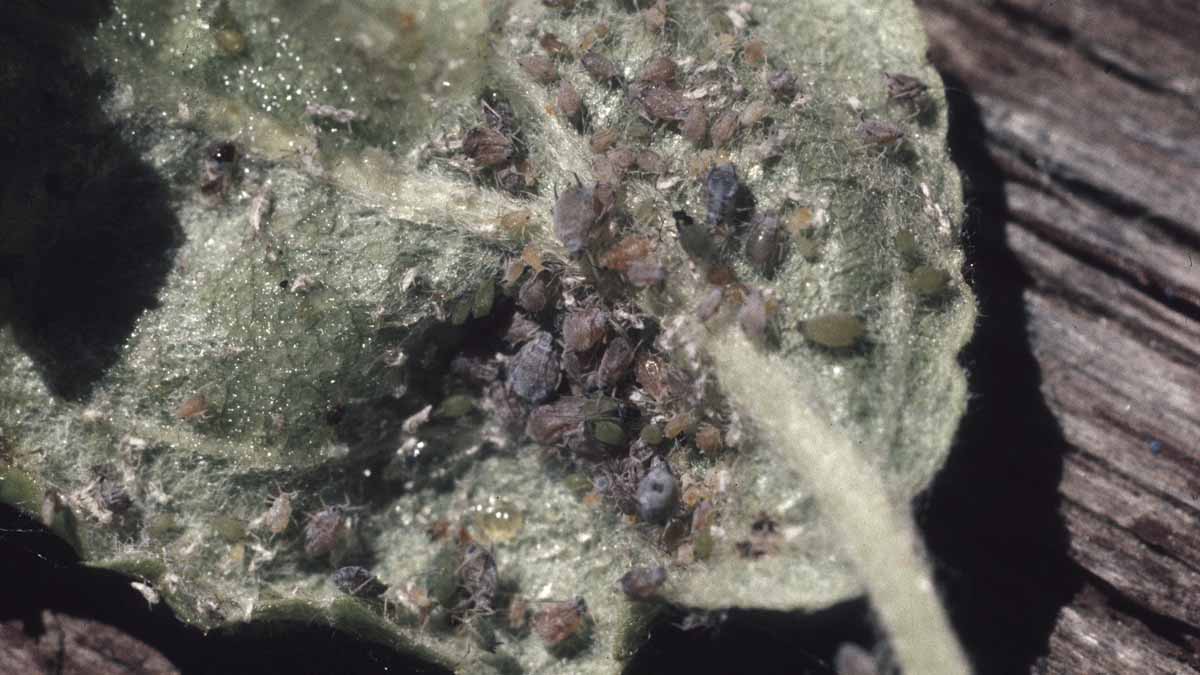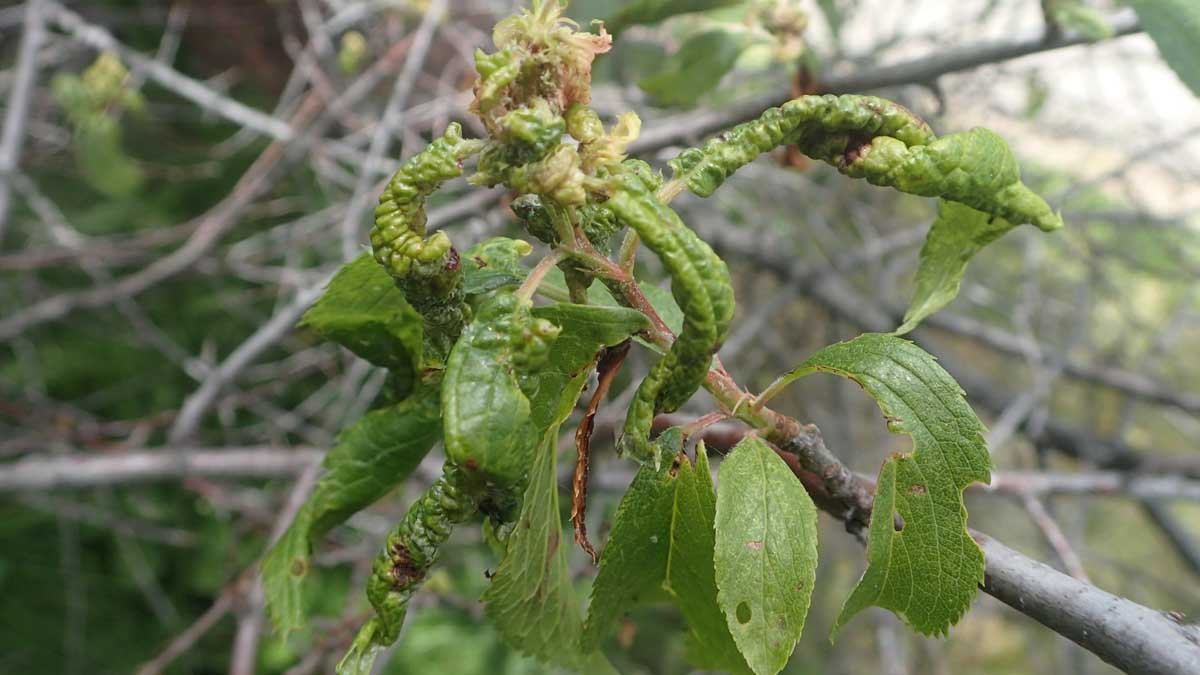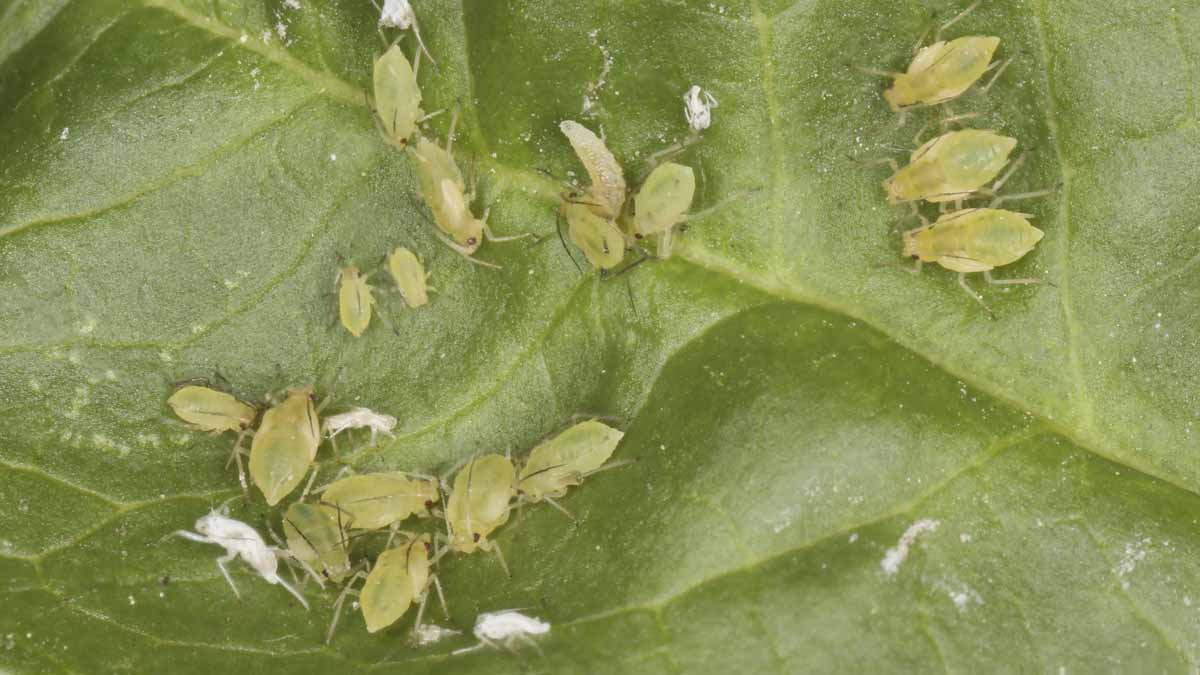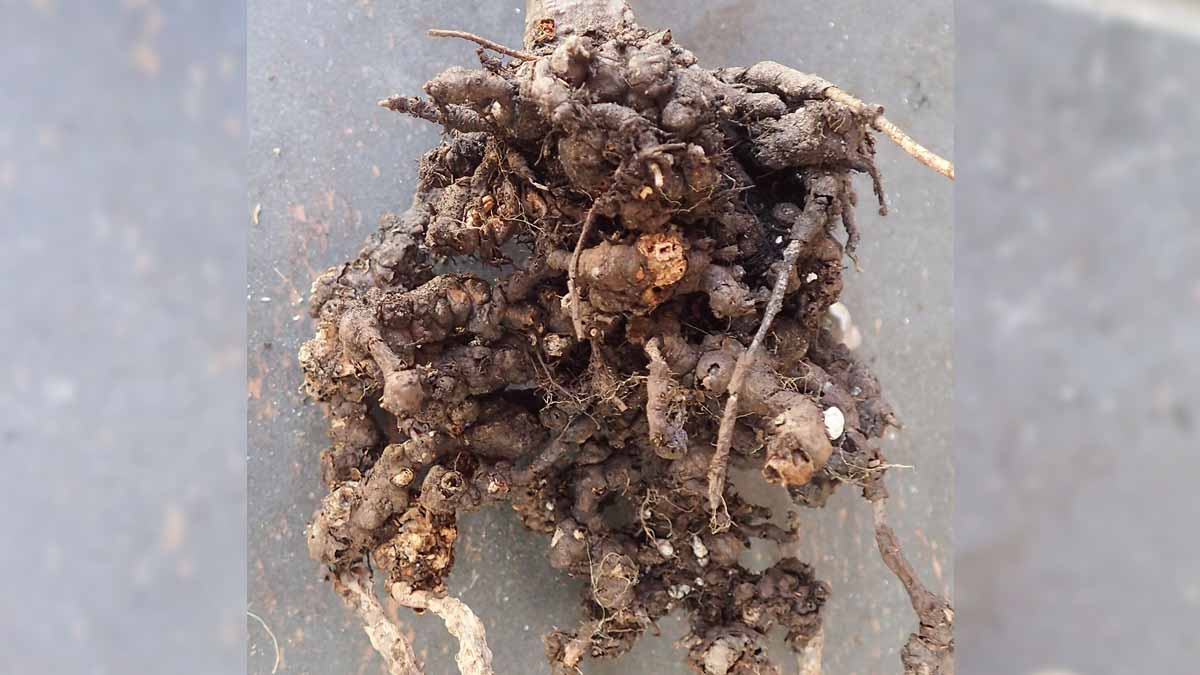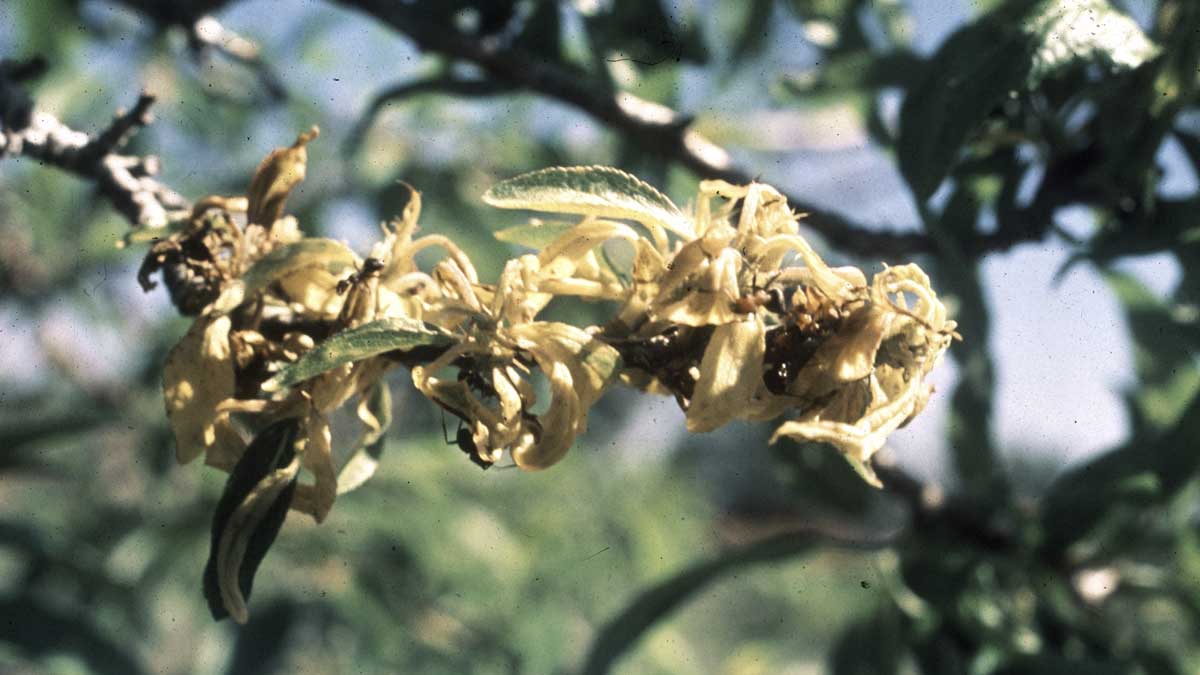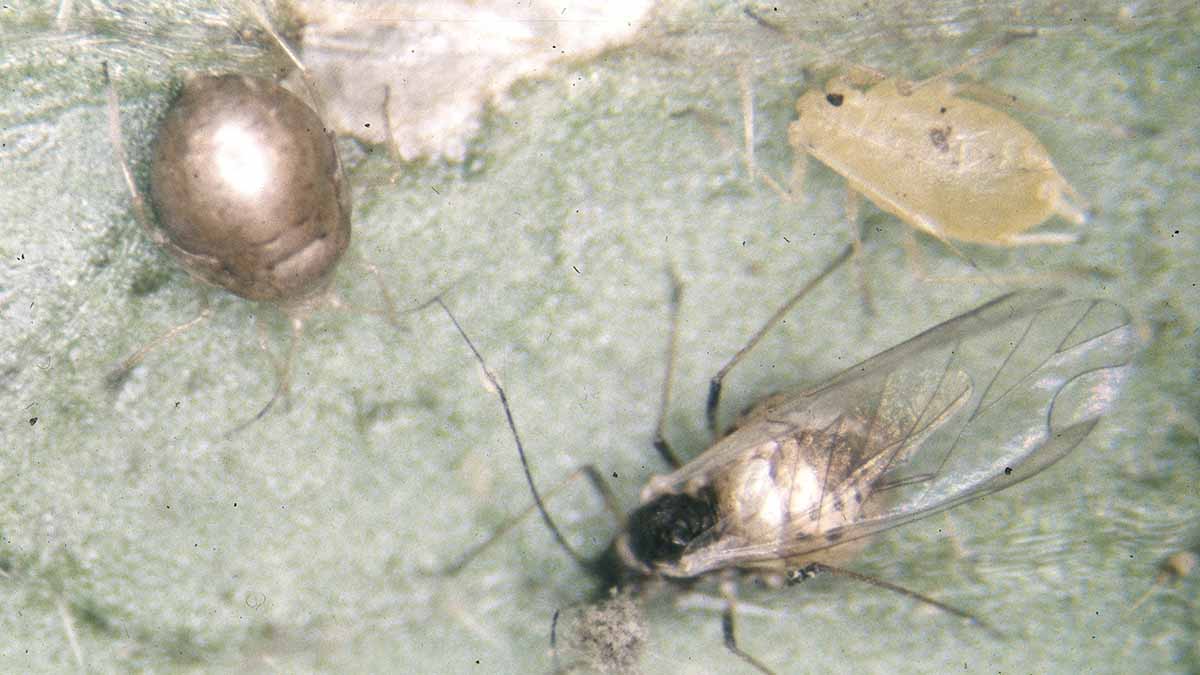Aphids
Pest Common Name
- Aphids (Aphididae)
- Woolly Apple Aphid (Eriosoma lanigerum)
- Green Apple Aphid (Aphis pomi)
- Mealy Plum Aphid (Hyalopterus pruni)
- Rosy Apple Aphid (Dysaphis plantaginea)
- Leaf Curl Plum Aphid (Brachycaudus helichrysi)
- Green Peach Aphid (Myzus persicae)
Woolly Apple Aphid (Eriosoma lanigerum)
- Year-round hosts: apple, pear and hawthorn
- Notes on Damage
- Feeding on roots causes gal formation, inhibiting root function
- Feeding on twigs causes gal formation, stunting growth and sometimes leading to infection
- Honeydew can lead to sooty mold growth
Green Apple Aphid (Aphis pomi)
- Year round: apple, crabapple, pear and hawthorn
- Notes on Damage
- Can cause leaf and shoot curling
- Not usually harmful to established trees
- Usually found on shoots, watersprouts and undersides of leaves
- Honeydew can lead to sooty mold growth
Mealy Plum Aphid (Hyalopterus pruni)
- Winter hosts: apricot, peach, nectarine, plum and prune
- Summer hosts: cattails and reeds
- Moves from winter to summer hosts around June and July
- Notes on Damage
- Can cause leaf and shoot curling, as well as fruit deformation
- Honeydew can lead to sooty mold growth
Rosy Apple Aphid (Dysaphis plantaginea)
- Winter hosts: apple, occasionally pear
- Summer hosts: plantain
- Moves from winter to summer hosts in late June or early July
- Notes on Damage
- Can cause leaf and shoot curling, as well as fruit deformation
- Honeydew can lead to sooty mold growth
Leaf Curl Plum Aphid (Brachycaudus helichrysi)
- Winter hosts: plum, prune
- Summer hosts: asters
- Moves from winter to summer hosts in early summer, around May
- Notes on Damage
- Can cause leaf and shoot curling, dropping of flowers and young fruit
- Transmits plum pox
- Can cause overall tree stunting and reduced fruit sugar content
- Honeydew can lead to sooty mold growth
Green Peach Aphid (Myzus persicae)
- Winter hosts: plum, peach and apricot
- Summer hosts: hundreds of crops, vegetables, ornamentals and weeds
- Move from winter to summer hosts in early summer
- Notes on Damage
- Feeding can cause distortion in leaves, shoots and fruits (particularly nectarines)
- Large populations can stunt tree growth, and cause flowers to fall and young fruit to abort
- Honeydew can lead to sooty mold growth
There are dozens of species of aphid in Idaho, but they are all generally oval or pear-shaped, soft-bodied and 1/32-1/8 inch (1-3.5 mm) long. Adult aphids can be either winged or wingless. Nymphs (immatures) are always wingless, resembling wingless adults, only smaller. Aphids have piercing/sucking mouthparts that they use to feed on plant sap. You can tell the difference between aphids and other small insects by looking for aphids’ cornicles, small rear-facing “tailpipe” like appendages near the end of the abdomen and the presence of a sugary secretion called “honeydew” under the aphid colony. Aphids also do not usually move rapidly when disturbed, another trait that can help differentiate them from other small insects they might be confused with such as leafhoppers (Figures 1-6).






Biology
Different aphid species have unique biologies. Some aphids are specialists, only feeding on one type of plant. Other aphids are generalists and are able to feed on a wide variety of plants. Furthermore, while some aphid species remain on a single host plant species year-round, others have different winter host plants versus summer host plants. Most aphids that are pests in fruit trees live on fruit trees only in the winter and spring, moving to weeds and other herbaceous plants in the summer. However, some, notably the wooly apple aphid, use fruit trees as summer hosts, and green apple aphids can remain on apple year-round.
Aphid reproduction also differs between species, but most species undergo both sexual and asexual reproduction, depending on the time of year. Aphids reproduce rapidly, there will be individuals from multiple generations within a single colony at any one time. Aphids from different generations will look similar, with immature aphids (also called nymphs) just looking like miniature adults. Most often, you will see aphids with no wings, as these form the bulk of aphid colonies you might find on your plants. However, you may also find winged aphids. These are not a different species but are produced during certain times of the year to allow the aphids to disperse when colonies grow too large, or when it is necessary to move between summer and winter hosts.
Damage
Aphids feed by piercing plant tissues and sucking out sap containing vital nutrients. They may feed on leaves, stems, flowers, fruits and occasionally on roots. Usually, established trees can tolerate low to moderate numbers of aphids without suffering significant damage. However, large numbers of aphids can cause damage to young plants or cause shoot growth to be stunted in some varieties. Some aphids feed on fruits directly, causing distortion. Aphids can also cause damage to fruit when their sugary excretion, honeydew, drips onto the fruit, where black sooty mold will then often grow. Sooty mold can cause russeting and downgrading of fruit.
Aphid feeding damage can manifest as yellowed or curled leaves, and overall distorted growth and plant stunting (Figures 7-8). Aphid infestations can also lead to damage when their sugary excretion, called honeydew, attracts other pests or leads to growth of sooty mold fungi. Many plants are also susceptible to aphid-transmitted viruses that can cause significant damage and yield loss. Symptoms differ among viruses but often include yellowing, mottling or curling of leaves and overall stunting. Unfortunately, aphid-transmitted viruses can be hard to control once both aphids and virus are present. It takes an aphid only minutes to transmit virus to a host plant, so insecticides cannot work rapidly enough to avoid spread of virus among susceptible hosts.


Monitoring
When caught early, aphid infestations are much easier to manage, so check trees frequently. Scout for aphids at least twice a week, paying particularly close attention during the late spring when populations tend to grow rapidly. Aphids are most often found on leaves but can be on stems and flowers as well. When checking leaves, make sure to check the undersides, as many aphid species prefer to build colonies there.
When scouting for aphids, look for beneficial insects such as ladybugs, lacewings and syrphid fly larvae, and aphid “mummies” that are a sign that parasitoids are at work. Also look for aphids that have been killed by disease or fungi. These aphids may appear bloated, off-color, flattened to the leaf surface or fuzzy. The presence of predators, parasitoids, disease or beneficial fungi may be sufficient to reduce aphid numbers significantly within a few days, mitigating the need for other control measures.
Management
Primary Management Tactics
Avoiding the use of broad-spectrum insecticides can help maintain populations of natural enemies that keep aphid numbers from reaching damaging levels. When considering the use of more aggressive control measures, remember that mature trees can usually tolerate mild to moderate aphid infestation and pruning out localized infestations may achieve sufficient control. However, if more aggressive measures are deemed necessary, consider your choice of insecticide carefully, keeping in mind impacts on beneficial insects.
Physical
- Prune out localized infestations
- Use strong sprays of water to knock aphids off plants
Cultural
- Consider resistant root stocks
- Manage potential sources of aphids including many types of weeds, mustard plants and crabgrass
- Avoid excess fertilization with nitrogen, which fosters aphid population growth
Biological
- Avoid the use of broad-spectrum pesticides to conserve natural enemies of aphids such as:
- Generalist predators including lady beetles (adults and larvae), lacewing larvae and soldier beetles
- Parasitic wasps that lay their eggs within aphids, where the developing larvae kill the aphid, leaving “mummies” (Figure 9)
- Managing ants (e.g., using Tanglefoot around trees, ant stakes or containerized baits) can help control aphids in some situations, as ants may feed on aphid honeydew and protect them from natural enemies

Chemical
- Insecticidal soaps, horticultural oils or plant derived oils such as neem oil are often effective and have reduced risks to beneficial insects, people and pets
- If using synthetic insecticides, keep in mind that:
- Broad spectrum insecticides may remove natural enemies, leading to aphid outbreaks later in the season
- You can check the opened database to see what the impact of particular pesticides might be on natural enemies
- Multiple applications of the same pesticide may lead to insecticide resistance
- Recommendations for pesticides to use in the management of aphids can be found on the PNW Pest Management Handbooks website
Pesticide Warning
Always read and follow the instructions printed on the pesticide label. The pesticide recommendations in this University of Idaho webpage do not substitute for instructions on the label. Pesticide laws and labels change frequently and may have changed since this publication was written. Some pesticides may have been withdrawn or had certain uses prohibited. Use pesticides with care. Do not use a pesticide unless the specific plant, animal or other application site is specifically listed on the label. Store pesticides in their original containers and keep them out of the reach of children, pets and livestock.
Trade Names — To simplify information, trade names have been used. No endorsement of named products is intended nor is criticism implied of similar products not mentioned.
Groundwater — To protect groundwater, when there is a choice of pesticides, the applicator should use the product least likely to leach.
- Figures 1, 3-5, 7-9. Whitney Cranshaw, Colorado State University, Bugwood.org
- Figure 2. Jim Baker, North Carolina State University, Bugwood.org
- Figure 6. Erik J. Wenninger, University of Idaho
Desiree Wickwar, Entomologist, IPM Project Manager
2023







